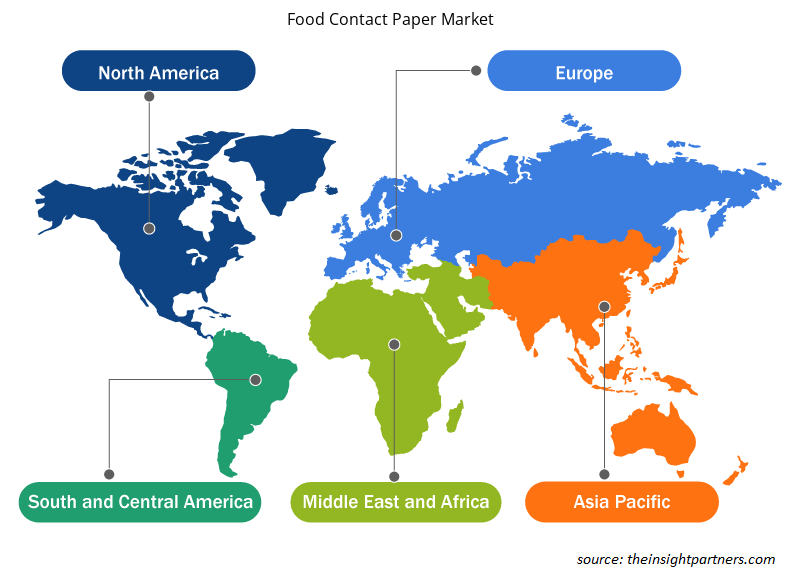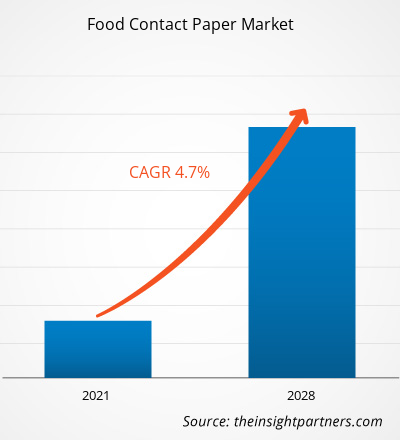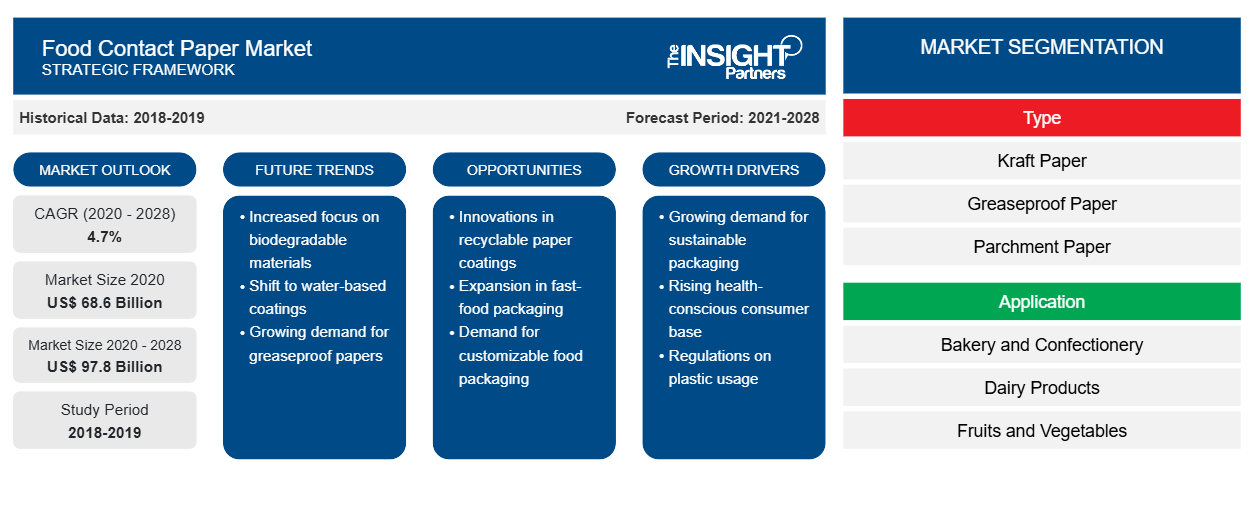Nel 2020, il mercato della carta a contatto con gli alimenti era valutato 68,6 miliardi di dollari USA e si prevede che raggiungerà i 97,8 miliardi di dollari USA entro il 2028; si prevede una crescita a un CAGR del 4,7% dal 2021 al 2028.
Le carte per il contatto con gli alimenti sono utilizzate come materiali di imballaggio primari per vari prodotti alimentari, come prodotti da forno, dolciumi, carne, snack e prodotti di macinazione dei cereali. Le carte sono alternative sostenibili a molti altri materiali di imballaggio alimentare, come plastica e vetro. Le crescenti iniziative delle aziende per ridurre la loro impronta di carbonio stanno influenzando l'adozione di carta per il contatto con gli alimenti in tutto il mondo. L'aumento della domanda di imballaggi alimentari sostenibili ed ecologici ha anche aumentato la domanda di imballaggi di carta alimentare.
Nel 2020, l'Asia Pacifica ha dominato il mercato globale della carta a contatto con gli alimenti e si prevede che continuerà a dominare durante il periodo di previsione. La crescente industria della ristorazione nei paesi asiatici, la crescente consapevolezza ambientale, le crescenti iniziative governative per vietare gli imballaggi in plastica in diversi paesi asiatici dovrebbero accelerare la domanda di soluzioni di imballaggio ecologiche e sostenibili, che guiderebbero la crescita del mercato della carta a contatto con gli alimenti nell'Asia Pacifica.
Personalizza questo report in base alle tue esigenze
Riceverai la personalizzazione gratuita di qualsiasi report, comprese parti di questo report, o analisi a livello nazionale, pacchetto dati Excel, oltre a usufruire di grandi offerte e sconti per start-up e università
-
Scopri le principali tendenze di mercato in questo rapporto.Questo campione GRATUITO includerà analisi di dati che spaziano dalle tendenze di mercato alle stime e alle previsioni.
Molti settori, come quello dei prodotti chimici e dei materiali, hanno dovuto affrontare sfide senza precedenti a causa della pandemia di COVID-19. A causa della carenza di materie prime e manodopera, della chiusura delle fabbriche e di altre difficoltà operative in base ai protocolli di sicurezza COVID-19, i produttori di prodotti per imballaggio hanno dovuto affrontare una contrazione delle vendite durante i primi mesi della pandemia. Inoltre, il cambiamento nello stile di vita dei consumatori e le loro mutevoli abitudini alimentari hanno ridotto il consumo di cibo pronto all'uso e da esterno a causa della diffusione del virus, il che ha influenzato negativamente la domanda di carte per il contatto con gli alimenti. Tuttavia, poiché diversi paesi stanno revocando il lockdown con adeguate misure precauzionali, è probabile che la domanda di carte per il contatto con gli alimenti torni in carreggiata. Poiché il lockdown è stato imposto in vari paesi, il settore dell'e-commerce ha assistito a una domanda significativa di vari prodotti, come alimenti confezionati e generi alimentari, tra cui frutta e verdura fresca, a causa della chiusura dei negozi offline, che ha alimentato l'utilizzo di carte per il contatto con gli alimenti.
Approfondimenti di mercato
Domanda crescente di soluzioni di imballaggio riciclabili e biodegradabili
L'imballaggio biodegradabile e riciclabile è stato un'alternativa interessante alle opzioni di imballaggio monouso sia per i consumatori che per i produttori. L'imballaggio per la ristorazione genera una notevole quantità di rifiuti nelle discariche negli Stati Uniti. Secondo un rapporto pubblicato dall'Agenzia per la protezione ambientale degli Stati Uniti, i rifiuti alimentari e gli imballaggi rappresentano la maggior parte dei materiali smaltiti in discarica negli Stati Uniti. Poiché l'imballaggio di carta è biodegradabile, è preferibile all'imballaggio riciclabile. L'uso di imballaggi alimentari riciclati aumenta le possibilità di contaminazione, con conseguenti potenziali effetti sull'ambiente e sulla salute umana. Le crescenti iniziative dei governi di tutto il mondo sull'uso di sacchetti di plastica monouso stanno spingendo la domanda di soluzioni di imballaggio riciclabili ma sostenibili, portando a una maggiore domanda di carte a contatto con gli alimenti.
Tipo Informazioni
In base al tipo, il mercato della carta a contatto con gli alimenti è segmentato incarta kraft, carta antigrasso, carta pergamena e altre. Il segmento della carta kraft ha detenuto la quota di mercato maggiore nel 2020. Le carte kraft naturali hanno fibre vergini pure, il che le rende una soluzione di imballaggio ideale per il contatto con gli alimenti. La carta è sempre più utilizzata per la produzione di vari prodotti di carta per il contatto con gli alimenti, come sacchetti di carta, sacchi di carta, carta da imballaggio e piatti di carta. La carta kraft naturale è sempre più utilizzata anche per realizzare sacchetti della spesa per frutta e verdura fresca grazie alla sua elevata resistenza.
Mondi; Westrock Company; Georgia-Pacific LLC; Twin River Paper Company; UPM; Ahlstrom-Munksjö; GM Packaging (UK) Ltd; Superiorpaper Pty Ltd. TopCare; e KRPA Holding CZ, sono tra i principali attori che operano nel mercato della carta a contatto con gli alimenti. I principali attori del mercato stanno adottando strategie come fusioni e acquisizioni e lanci di prodotti per espandere la loro presenza geografica e la loro base di consumatori.
Segnala i riflettori
- Tendenze progressive nel settore della carta a contatto con gli alimenti per aiutare gli operatori a sviluppare strategie efficaci a lungo termine
- Strategie di crescita aziendale adottate dalle aziende per garantire la crescita nei mercati sviluppati e in via di sviluppo
- Analisi quantitativa del mercato globale della carta a contatto con gli alimenti dal 2019 al 2028
- Stima della domanda di carta a contatto con gli alimenti in vari settori
- Analisi di Porter per illustrare l'efficacia degli acquirenti e dei fornitori che operano nel settore per prevedere la crescita del mercato
- Sviluppi recenti per comprendere lo scenario competitivo del mercato e la domanda di carta a contatto con gli alimenti
- Tendenze e prospettive di mercato, insieme ai fattori che guidano e frenano la crescita del mercato della carta a contatto con gli alimenti
- Comprensione delle strategie che sostengono l'interesse commerciale in relazione alla crescita del mercato globale della carta a contatto con gli alimenti, aiutando nel processo decisionale
- Dimensioni del mercato del vetro float in vari nodi del mercato
- Panoramica dettagliata e segmentazione del mercato globale della carta a contatto con gli alimenti, nonché delle dinamiche del settore
- Dimensioni del mercato della carta a contatto con gli alimenti in varie regioni con promettenti opportunità di crescita
Approfondimenti regionali sul mercato della carta a contatto con gli alimenti
Le tendenze regionali e i fattori che influenzano il Food Contact Paper Market durante il periodo di previsione sono stati ampiamente spiegati dagli analisti di Insight Partners. Questa sezione discute anche i segmenti e la geografia del Food Contact Paper Market in Nord America, Europa, Asia Pacifico, Medio Oriente e Africa, e Sud e Centro America.

- Ottieni i dati specifici regionali per il mercato della carta a contatto con gli alimenti
Ambito del rapporto di mercato sulla carta a contatto con gli alimenti
| Attributo del report | Dettagli |
|---|---|
| Dimensioni del mercato nel 2020 | 68,6 miliardi di dollari USA |
| Dimensioni del mercato entro il 2028 | 97,8 miliardi di dollari USA |
| CAGR globale (2020 - 2028) | 4,7% |
| Dati storici | 2018-2019 |
| Periodo di previsione | 2021-2028 |
| Segmenti coperti |
Per tipo
|
| Regioni e Paesi coperti |
America del Nord
|
| Leader di mercato e profili aziendali chiave |
|
Densità degli attori del mercato della carta a contatto con gli alimenti: comprendere il suo impatto sulle dinamiche aziendali
Il mercato della carta per contatto alimentare sta crescendo rapidamente, spinto dalla crescente domanda degli utenti finali dovuta a fattori quali l'evoluzione delle preferenze dei consumatori, i progressi tecnologici e una maggiore consapevolezza dei benefici del prodotto. Con l'aumento della domanda, le aziende stanno ampliando le loro offerte, innovando per soddisfare le esigenze dei consumatori e capitalizzando sulle tendenze emergenti, il che alimenta ulteriormente la crescita del mercato.
La densità degli operatori di mercato si riferisce alla distribuzione di aziende o società che operano in un particolare mercato o settore. Indica quanti concorrenti (operatori di mercato) sono presenti in un dato spazio di mercato in relazione alle sue dimensioni o al valore di mercato totale.
Le principali aziende che operano nel mercato della carta a contatto con gli alimenti sono:
- Mondi
- Società Westrock
- Georgia-Pacific LLC
- Società di carta Twin River
- UPM
Disclaimer : le aziende elencate sopra non sono classificate secondo un ordine particolare.

- Ottieni una panoramica dei principali attori del mercato della carta a contatto con gli alimenti
Mercato della carta a contatto con gli alimenti, per tipo
- Carta Kraft
- Carta da forno
- Carta pergamena
- Altri
Mercato della carta a contatto con gli alimenti, per applicazione
- Panetteria e pasticceria
- Prodotti lattiero-caseari
- Frutta e verdura
- Carne, pesce e pollame
- Altri
Profili aziendali
- Mondi
- Società Westrock
- Georgia-Pacific LLC
- Società di carta Twin River
- UPM
- Ahlstrom-Munksjö
- GM Packaging (Regno Unito) Ltd
- Carta superiore Pty Ltd
- Cura superiore
- KRPA Holding CZ, come
- Analisi storica (2 anni), anno base, previsione (7 anni) con CAGR
- Analisi PEST e SWOT
- Valore/volume delle dimensioni del mercato - Globale, Regionale, Nazionale
- Industria e panorama competitivo
- Set di dati Excel
Report recenti
Rapporti correlati
Testimonianze
Motivo dell'acquisto
- Processo decisionale informato
- Comprensione delle dinamiche di mercato
- Analisi competitiva
- Analisi dei clienti
- Previsioni di mercato
- Mitigazione del rischio
- Pianificazione strategica
- Giustificazione degli investimenti
- Identificazione dei mercati emergenti
- Miglioramento delle strategie di marketing
- Aumento dell'efficienza operativa
- Allineamento alle tendenze normative























 Ottieni un campione gratuito per - Mercato della carta a contatto con gli alimenti
Ottieni un campione gratuito per - Mercato della carta a contatto con gli alimenti